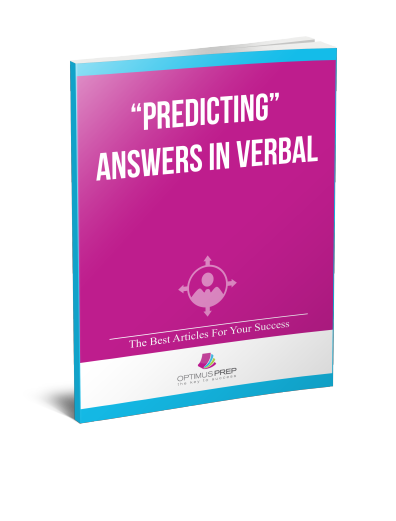
As soon as we see the word “predict”, we are heading towards picking the answer choice without applying all the knowledge we have attained.
For a moment, let us keep verbal aside and try to predict the answer of this maths question
A factory has three types of machines, each of which works at its own constant rate. If 7 Machine As and 11 Machine Bs can produce 250 widgets per hour, and if 8 Machine As and 22 Machine Cs can produce 600 widgets per hour, how many widgets could one machine A, one Machine B, and one Machine C produce in one 8-hour day?
A. 400
B. 475
C. 550
D. 625
E. 700
Can you predict the correct choice?
The simple answer is No.
Now let us shift our attention back to the Verbal section.
As we were not able to “predict” the answer in the case of the Math question since the Math section is governed by some rules, similarly the Verbal section is also governed by some rules and by following them, we can reach the correct answer.
However in the circumstance, where we are unable to find an answer, the set of rules for the Verbal section can bring us close to the correct option and then we can “predict” the answer and in turn increase our probability of getting it right. We can call this approach as a value driven approach, wherein you weight all the choices, strike off the answer choices which are wrong for sure and then mark the answer.
This approach is different for different sections of Verbal and we have written a detailed method on how to apply this approach while solving the problems:
Sentence Correction:
The most common way to predict an answer here is to choose the one which “sounds” correct. This option might take you to the correct option sometimes, but more often than not, the authors of the question will put this trap option that sounds right for you and the correct option would be some other option.
Thus this method of predicting the correct option based on “sound” should be avoided
You should always start off by trying to find out the errors in the question stem itself. For example: if the error is related to parallelism, find out that error in all the other choices and strike them off. This will give you a direction to look into and will reduce your time and effort required in solving the question
At this point of time, you would have striked off at least 2 -3 options. The next step should be to find out the remaining errors in the options left. However, if you have no clue about the error, “predicting” an answer at this point of time increases your probability of “predicting” the correct answer.
Critical Reasoning:
The process of “predicting” the answer is of utmost importance here. You should always start off by reading the question stem and not the premise. One you have read the question stem, now read the premise keeping the question in mind. This will help you in a method called pre thinking.
The main advantage of pre thinking is that you formulate a somewhat vague idea of what the answer choice should be about, or in other words, predict the answer choice.
For example, if the question asks you to find out a statement that strengthens the premise, then you should be thinking about things that will help you to strengthen the premise. For instance, if the premise talks about a scientific discovery, then certain findings related to that discovery might be able to strengthen the premise.
This way of “predicting” the answer choice by pre thinking is surely going to do wonders to your score.
Reading Comprehension:
In the RC questions, the authors of the questions play a very smart game. They deliberately place options in the questions which sound correct and are easy to “predict” but are most of the times the wrong options. The author plays with your mind by putting in the options that are easy to comprehend and contain some information from the passage, but that information might not be useful for the question at hand. One such example can be the half correct options. These options contain information that is from the passage, but is only half related to the question stem. The other part of the option might talk about something that has not been asked.
Thus doing your work up front becomes all the more important in the case of Reading Comprehension questions. Once you are done with the reading of the passage and have made your notes, you should refer back to them and identify what part of the passage, the question is linked with. Then try to find out the answer by going through your notes on that particular part.
Another important point to note is the tone of the author. You can eliminate choices which do not conform to the tone of the author and then you can come to the correct answer choice.
This way, you will be able to “predict” the correct option with far more accuracy as compared to just looking at the question stem and then at the options.
The bottom line: You will have to do the hard work before arriving at the correct answer and should not just go ahead and pick the answer that sounds correct to your ears.
SC: Strike of answers based on your knowledge of the rules and then predict from the remaining ones if you are not sure.
CR: Always read the question stem first and then pre-think. This will allow you to formulate the answer beforehand based on your understanding of the premise.
RC: Refer your notes after identifying the part of the passage from where the question is and make a note of the tone of the passage.

